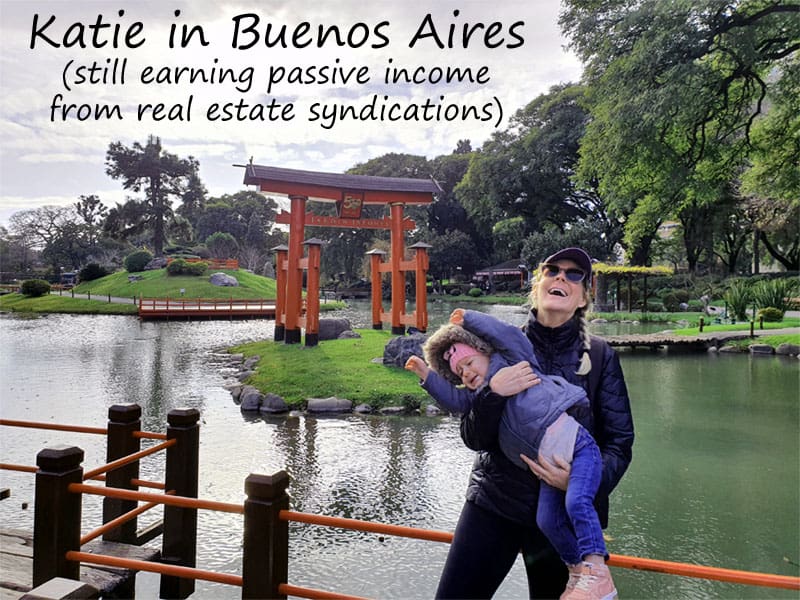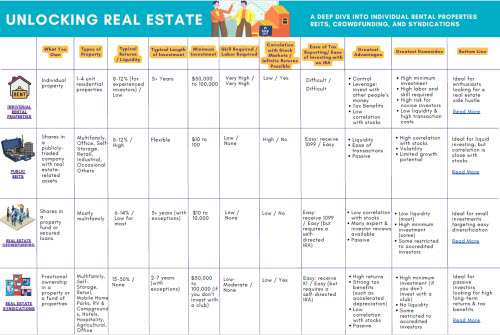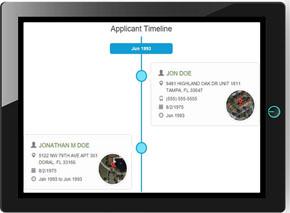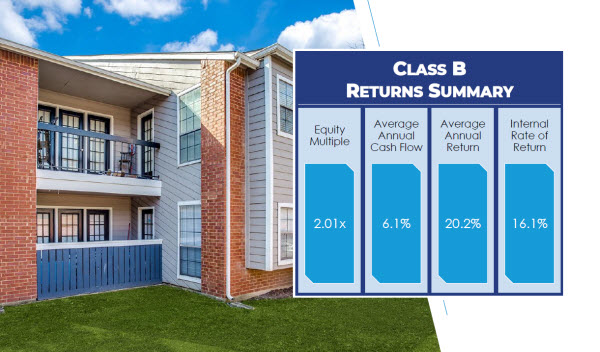
I’ve owned dozens of rental properties since 2005. Today, however, I own none.
Why the change of heart? Did I stop believing in real estate as a means to reach financial independence and early retirement?
Not at all. I’ve just changed how I invest in real estate. I leave the renovations and renter phone calls at 2am to the scrappy young investors who don’t mind all the headaches.
Today, I own over 1,500 units across the U.S. and I never field a phone call or negotiate with contractors. But I still get all the tax advantages, rental cash flow, and appreciation that active investors earn.
Active vs. Passive Real Estate Investing
Everybody understands active real estate investing. You know how flipping houses or becoming a landlord works. You come up with a down payment, get an investment property loan, perhaps make some property repairs, and either sell or keep the property as a rental.
Don’t get me wrong, it comes with plenty of advantages. In the case of flipping houses, you can earn a relatively quick return in the tens of thousands. Landlords score great rental property tax deductions and earn “forever income” in the form of rental property cash flow while their renters pay off their mortgage for them. The property appreciates over time, and rents rise over time, even as your mortgage payment remains fixed (why real estate protects against inflation).
For all those upsides, direct real estate investing comes with its share of downsides. It takes enormous amounts of work: work to find good deals on properties, work to find financing, work to oversee and negotiate with contractors, work to advertise vacant units and screen tenants and sign leases and collect rents and maintain units over time.
I’ve done all of that work. And while I didn’t mind it at first, I eventually got sick of it.
After moving abroad, I started researching other ways to invest in real estate. Options that didn’t involve active investment and all those headaches, but still delivered all the benefits of real estate investing.
What Is Passive Investment in Real Estate?
Put simply, passive real estate investing just involves your money, not your time.
Passive investment in real estate doesn’t require you to buy properties, line up financing, make renovations or repairs, or manage renters. You simply write a check and sit back while the rental income flows in and the properties appreciate or interest collects.
Sounds great, right? But how do you actually invest passively in real estate?
Related Article Read: Ways to find pre foreclosure homes.
Related Article Read: Guide to Driving For Dollars.
8 Options for Passive Investment in Real Estate
Fortunately for you, you have countless ways to invest in real estate passively. They typically fall into one of these eight broad buckets.
Explore each of these to decide which passive real estate investing option fits your goals best.
1. Public REITs
I’ll be honest: I don’t love publicly-traded REITs. But they’re the option that most investors know best, so we’ll start there.
Real estate investment trusts are publicly-traded companies that meet certain SEC criteria. At least 75% of their assets must be backed by real estate, and they must pay out at least 90% of their profits each year to investors in the form of dividends, among other requirements. You can buy and sell them on public stock exchanges through your brokerage account, like any other stock. Similarly, you can buy shares in ETFs or mutual funds that own multiple REITs.
While that all sounds great on paper, REITs come with one huge drawback that defeats the entire purpose of “diversifying into real estate.” They’re just too correlated with stock markets. When the stock market crashes, public REITs tend to crash right alongside them — even when the underlying real estate assets are doing just fine.
Read: no diversification benefit.
Go a little further afield for passive investments in real estate. It’s worth the (small) extra effort.
2. Private REITs
Not all REITs trade on public stock exchanges. Over the last decade, some real estate crowdfunding companies have launched their own private REITs.
Rather than buy shares through your brokerage account, you buy them directly from the crowdfunding platform. Because they don’t trade on a secondary market, they don’t come with the volatility of stocks.
But that also raises their greatest downside: lack of liquidity. You can only sell shares back to the crowdfunding company, and most hit you with an early redemption penalty if you do so within three to five years.
If you can live with the long-term commitment, they offer all the other benefits promised by public REITs. You get the ongoing passive income from dividends, the appreciation, and the tax benefits. Perhaps most importantly, you get true diversification from the stock market.
Like publicly-traded REITs, private REITs might own properties directly (equity REITs) or own debt secured by property (mortgage REITs). Or they might own a blend of the two, as many Fundrise REITs do. Check out Fundrise and Streitwise as two reputable options (full Fundrise review and Streitwise review for further reading).
Real estate investment trusts offer a simple way to invest in many different real estate markets with a single click. Some, like Fundrise, even include single-family homes, among other types of investment properties.
3. Crowdfunded Loans Secured by Real Estate
Some real estate crowdfunding companies let you pick and choose individual loans to fund.
My favorite of these is Groundfloor. You can invest as little as $10 toward individual loans secured by properties (although the minimum initial transfer to open an account with Groundfloor is $1,000).
These are short-term purchase-rehab loans to real estate investors, paying 7.5-15% interest. They typically repay in full within 6-24 months, and you can see the repayment term when you invest. Since its launch in 2013, Groundfloor has returned remarkably consistent returns around 10% when you average all loans together each year. Read our full Groundfloor review here for full details.
For an entirely different model, check out Concreit. They offer a pooled fund model, where you invest on a combined fund rather than picking and choosing loans. It pays lower returns in the 5.5-6.5% range, but here’s the kicker: you can withdraw your money at any time.
Consider it an excellent holding area for your investment capital while you wait for other real estate investments to come along, or as a secondary emergency fund.
4. Private Notes
Alternatively, you can lend money to other real estate investors yourself. The legal document that the borrower signs is called a promissory note (or just “note” for short). It’s up to you whether or not you want to record a lien to enforce your loan.
I myself have lent a private note to a real estate investing couple in Ohio. They’ve paid me 10% interest every quarter like clockwork since 2019.
Word to the wise, however: only lend a private note to investors you know personally and trust implicitly. Don’t lend money to anyone — even someone you know well — if they don’t have a long history of success in real estate investing.
Don’t count on earning a 15-30% rate of return like you might with a real estate syndication, but you can still earn solid returns with a steady stream of income.
5. Fractional Ownership of Rental Properties
In today’s world, you can do things with the click of a button that were much, much harder even a decade ago. That’s the beauty of disruptive technology in real estate.
Case in point: investing platforms that offer fractional ownership in real estate. For $20–100, you can buy ownership shares in rental properties. You collect your portion of the cash flow, in the form of monthly or quarterly distributions, and most real estate investing benefits. When the property sells, you get your share of the profits.
In some cases, you don’t even need to wait for the property to sell. Some online platforms offer a built-in secondary market, where owners can buy and sell shares from each other. That means you can sell at any time (or at least after an initial 3–12 month holding period, to prevent share churning).
Check out Ark7 and Lofty as examples of fractional ownership platforms that offer liquidity and secondary markets. Also check out Arrived, the oldest and best known of these platforms, which doesn’t offer a secondary market yet but has built a great reputation. Several of these platforms offer short-term Airbnb rentals, not just traditional long-term rentals.
I have some money in fractional rentals on Ark7 and Arrived. But my favorite passive investment in real estate is syndications.
6. Fractional Ownership of Apartment Complexes
What’s better than fractional ownership in a single-family rental property?
An ownership share in a 200-unit apartment community.
You benefit from an economy of scale, better cash flow, accelerated real estate depreciation, and higher barriers to entry keeping returns high. Best of all, the greater unit count provides stability: a single vacancy or repair won’t scuttle your returns. The vacancy rate typically remains pretty constant, as do maintenance costs.
You buy fractional ownership in multifamily properties through real estate syndications. These private investments typically pay 15–30% returns, between cash flow distributions and profits upon sale. In some cases, the syndicator refinances the property rather than selling, returning your investment capital back to you even as you keep your ownership interest in the property. It’s one of earning infinite returns on your investment.
Plus, you get full real estate tax benefits.
“Uh, if these are so awesome, why isn’t everyone investing in them?”
Several reasons: To begin with, they’ve historically been word-of-mouth investments among the wealthy. Most people have never heard of real estate syndications.
But even those who have often can’t invest in them. Many are only available to wealthy accredited investors, and most require a minimum investment of $50–100K.
Unless you invest as part of a real estate investment club like ours, that is. Our Co-Investing Club members can invest as little as $5K in each deal, and we propose new deals once a month on average.
7. Other Real Estate Syndications
Oh, one other thing about real estate syndications: they don’t just include apartment buildings.
You can invest in any type of commercial real estate, from self-storage facilities to mobile home parks, campgrounds to marinas, assisted living facilities to office space.
That means you can spread your money across many different industries and economic sectors. Our Co-Investing Club has invested in industrial real estate deals and retail property deals, in addition to multifamily properties. I personally invested in a campground, RV park, and marina deal that remains one of the best deals I’ve ever invested in.
Just a thought!
No matter the type of property, the tax advantages remain intact. You get to show a loss on paper for your tax return (at least in the early years), even as you rake in cash flow in the form of distributions. The paper losses help you offset your taxable income from other passive income streams.
Related Article Read: What Is the Due Diligence Period in Real Estate?
Related Article Read: How to transfer property from a person to an LLC.
8. Private Real Estate Funds
As a sister option to real estate syndications, you can invest in a fund that owns many syndications or other real estate-related investments.
Some closed funds have a fixed start date and target close date — they buy commercial properties, hold them for a certain period of time, then sell them and pay everyone out. Open funds rotate through assets, buying properties and holding them for a while before selling, but always holding a wide mix of properties and assets.
With some funds, you know exactly what they plan to buy. With blind funds, you don’t know exactly what properties they’ll buy, but you know the general partner and their track record, and trust them to earn great returns for you.
Final Thoughts for Passive Investors in Real Estate
There’s no single best passive investment in real estate. All of the investment strategies above have their place, their pros and cons.
And while I would never discourage anyone from becoming a landlord or buying real estate directly, I do always ask them a question: How passionate are you about investing in real estate as a side hustle? Because that’s what it is — buying properties yourself is like working a part-time gig. That’s fine if you’re willing to learn the skills you need to succeed and put in the work to execute your plan.
But most people don’t want a real estate side hustle. They just want to diversify their investment portfolios to include real estate, ideally to feature many types of properties. And for them, I recommend passive investing in real estate.♦
What role do passive investments play in your real estate portfolio? What do you see as the pros and cons of passive real estate investing compared to active investing as a property owner?
More Real Estate Investing Reads:
About the Author

G. Brian Davis is a real estate investor and cofounder of SparkRental who spends 10 months of the year in South America. His mission: to help 5,000 people reach financial independence with passive income from real estate. If you want to be one of them, join Brian and Deni for a free class on How to Earn 15-30% on Fractional Real Estate Investments.



























I’ve been considering passive investing as a better alternative since I’m getting tired of dealing with tenant and contractor problems. It seems like there’s always something going wrong. I’m currently contemplating selling one or two properties to pursue that option.
I certainly hear you Anya!
Like you said, it’s important to carefully consider your personal risk profile and align investments with your long-term goals. A good investment for one person is a bad fit for someone else.
Amen Kylie!
Fractional Ownership of Rental Properties is like Real Estate Investing on Easy Mode! Just buy a tiny piece of a property, and watch the money roll in while you Netflix and chill! 🏠💤
Amen Ken 🙂
As a passive investor in real estate, I’ve discovered numerous hands-off options, such as public REITs, private notes, and fractional ownership of properties. Yet, it’s essential to thoroughly assess potential risks and consider own financial goals and risk tolerance when selecting the best option.
No question Bill!
Personally, I like the control of active real estate investments. Passive strategies serves as a supplementary option in my portfolio. Just my 2 cents.
Thanks for sharing your thoughts Limuel!